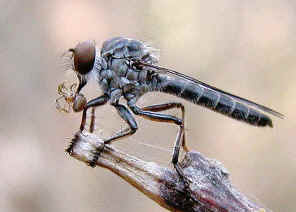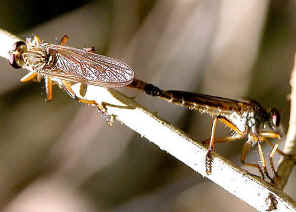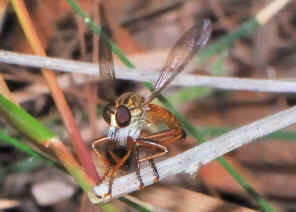|
| |
Order
Diptera
- This page contains pictures and information about the biology of Robber Flies that we found
in the Brisbane area, Queensland, Australia.
-
 -
- The Robber Flies are air hunter. They also known as an Assassin Fly and
Bee Killer.
They have piercing mouth-parts and strong legs which can catch prey on flight. They are medium to large
size flies with large eyes and necked head. They are active predators on flying
insects, unselective in prey species. They even prey on web weaving spiders.
Their mouthparts are the triangular proboscis
which insert into prey and suck the juice. Robust flies prefer sunlit area
to capture their prey.
-
- Most Robust flies are with noticeable "beard" of setae around the
face. It is believed that they serve as protection to their face from damage by
their prey. Anyway, they usually attack from the back side of their
prey.
-
 

- Bee
Killer Spider predator
Prey on other insects
- Most Robber Flies are reddish-brown in colour. Different species that we
found are looked similar and hard to be identified. Their
mouthpart is the large pointed proboscis. Their thorax and legs are hairy.
Their abdomen are long and slender. They are commonly seen in our backyard and in
the bushes in Brisbane.
-
 
 - Mimicking Wasps
-
- Quite a number of Robust flies species mimic wasps. Some of them are from
the subfamily
Dasypogoninae.
-
 
 - The mating pair
The mating pair
Taking off
-
- Female robber flies deposit creamy colour eggs on plants or in gaps within
soil, bark, or wood. Egg-laying habits are different depend on species and
habitat. Most species lay eggs in masses and are covered with protective
coating. Robber fly larvae live in the soil or in rotting wood. Larvae are
either predatory or parasitic, they feed on eggs, larvae and other soft-bodied insects.
-

- Robber fly pupa empty case
-
- They
pupate in the soil and move to soil surface emerge as adults (We have the
Giant Robber Fly egg-laying observation in this page).
-
Robber Fly Attacked Spider


-
- Insects are not always be the prey of spiders. Some insects attack spiders.
Robber Fly is one of those insects. On a early summer day afternoon, a medium
size Silver
Orb Wed spider was building its web. The spider had finished laying the
frame threads and radius of the web and about to put on the sticky spiral silk.
There was a medium size Robber Fly flying over the spider web. After the fly circled
two rounds, it attacked the spider on its abdomen. The fly punch its mouth
parts into the spider body. There was only very little struggling, then all
become motionless. The Robber Fly start feeding the spider on the unfinished
spider web. We believed if the spider web were finished, the Robber Fly may not win so
easily.
-
Robber Fly infected by fungus
-


 -
-
We found a number of times that this species robber fly was dead and resting on
grass or stems. On the body the growing fungus can be seen.
-
-



-
- We saw the fungus infections on other robber fly species, but seldom
on other insects. Although we do found other fungus infections on
spiders.
-
-


 -
-

-
- Reference:
- 1. Insects
of Australia, CSIRO, Division of Entomology, Melbourne University
Press, 2nd Edition 1991, p 757.
- 2. Insects of Australia and New Zealand - R. J. Tillyard, Angus
& Robertson, Ltd, Sydney, 1926, p362.
- 3. Giff Beaton's Robber Flies (Asilidae) of Georgia and the southeast
- by Giff Beaton, 2005.
- 4. Family
ASILIDAE - Australasian/Oceanian Diptera Catalog - Web Version, by
Greg Daniels.
- 5. Family ASILIDAE Robber Flies - Australian Biological Resources Study, Australian Faunal Directory.
[ Up ] [ Biology ] [ Laphriinae ] [ Ommatiinae ] [ Asilinae ] [ Bathypogoninae ] [ Phellinae ] [ Dasypogoninae ] [ Leptogasterinae ] [ Brachyrhopalinae ] [ Unidentified Robber Fly ]
| |
|























